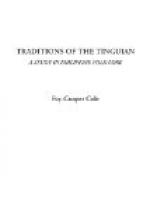Every tale emphasizes the importance of the Sayang ceremony and the spirit structure known as balaua. [53] The ceremony is nowhere described in full, but the many details which are supplied show that it was almost identical with that of to-day. The same is true of the Dawak, [54] which we find mentioned on three different occasions, and of the ceremony made to aid in locating lost or stolen articles. The most noticeable fact, to the person familiar with Tinguian life, is that these are the only ceremonies mentioned among the many known and practiced at present. More than a score of different rites are now well known to this people, and occupy a very considerable portion of their time and attention during the first four months of the year.
The failure to make mention of these very important events is explained, it seems to me, not by their absence, but by the fact that these rites vary in importance and that the privilege of celebrating them is hereditary in a family. Should one not entitled to hold such a ceremony desire to do so, he must first give, in order, all the lesser events, a costly procedure extending over a period of several years. The people of Kadalayapan and Kaodanan always appear as being closely related to the spirit Kaboniyan, [55] and exceedingly powerful. It seems probable that the story teller takes it for granted that all of them are entitled to hold the most important ceremony known to the Tinguian.
A prominent figure in these rites is the medium, through whom the ancient people generally conversed with the spirits, but in exceptional cases we found the heroes talking direct with the superior beings; however, this gift is not confined to the men of old, for in such tales as 55 and 59 people who are believed to have lived recently have conversed with the spirits and have even been joined to them in marriage.
The procedure in choosing a bride, the engagement, the pakalon, [56] and the marriage proper are all those of the present day, but the rules governing the marriage of relatives differ radically. As already noted, one of the chief qualifications for marriage, among the people of the tales, was relationship, and even cousins became husband and wife. Such a thing is unthinkable among the Tinguian of to-day; first cousins are absolutely barred from marrying, while even the union of second cousins would cause a scandal, and it is very doubtful if such a wife would be allowed to share in her deceased husband’s property. [57]
It appears that only one real [58] wife is recognized as legitimate, but that from “the first times” to the present a man might have as many concubines as he could secure.
So far as mythology and present day conditions can inform us the bride has always gone to the home of her husband and, for a time at least, has been subject to the dictations of her mother-in-law, although the couple are generally soon established in a home of their own, in the town of the groom. There is nothing in Tinguian life or tradition to indicate that they have ever had a clan system or a matriarchal form of government.




